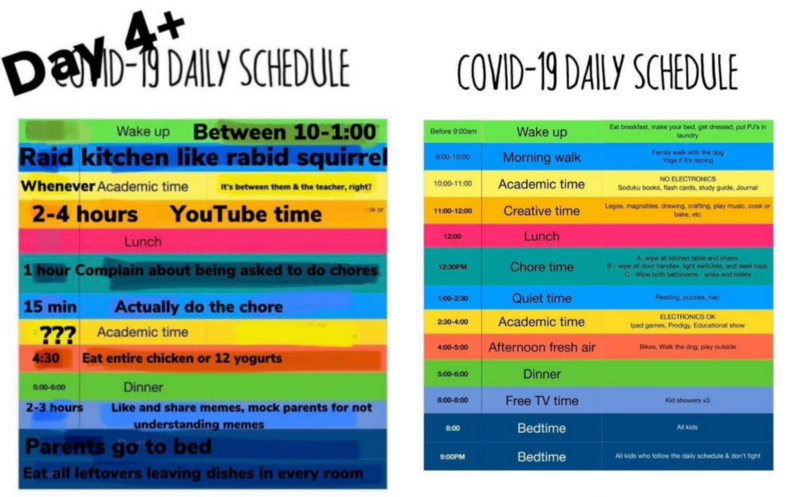With systems change comes heightened chaos. At Headrush, we know remote learning does not have to be a substitute for the real thing; in fact, with decades of experience running online learning, working online and currently operating as a remote, online company, we know the opposite is quite true. To help guide you, we thought we’d share some key thoughts to consider when transitioning to online learning to maximize the potential of what’s possible.
1. Keep it simple
Before scrambling into action, try a moderate-intensity, ramp-up into action when transitioning to an online environment. Simplicity is key. Of course, “simple” in this context is defined by the current skill and capacity of your staff and students, meaning, if your community has the privilege of mad tech training, tools and access, then perhaps simplicity to you means ramping up with more vigor in intensity. Regardless, it is better to do a few things well than to do too many things unsuccessfully. Your goals for the first few weeks should remain minimal and clear. First prioritize communication channels; Next, systematize daily routines, starting with check-ins. As you establish ground expectations and clear working channels of communication, this will help you ramp up for more complex structural implementations, like streamlining online curriculum or working on collaborative projects. Moving online should build slowly if done well. Improve team performance and inspire transformative action by checking in through virtual meet-ups or morning “huddles.”
2. Understand asynchronous vs. synchronous learning
When comparing, it’s important to note that both have advantages that will most likely make their way into your best online practices. Asynchronous learning enables students to complete projects without the constraints of having to be in a certain place at a certain time. Whether assigned through email, blog posts, or pre-recorded video lessons, students essentially have the autonomy to flow through the curriculum from any location. Synchronous learning is where a group of students are engaged in learning in real-time. Whether video conferencing through facebook or zoom, using virtual classrooms, or participating in live webinars, students are syncing up at the same time, regardless of physical location. This enables students to ask questions, collaborate freely, co-design projects, and receive feedback efficiently. While asynchronous learning offers lots of flexibility and is easier to implement as there is no need for scheduling, synchronous learning allows for invaluable moments of real-time audio-visual connection that you might otherwise miss when social distancing for months on end. Despite there being a broad spectrum of possibilities of how you can operationalize working online, orgs tend to work in a narrow field of that spectrum. Be intentional about how you blend these types of digital learning experiences together for your community.
For Headrush users, Headrush can handle the bulk of your asynchronous needs: Planning work, assigning tasks, Q&A, allowing for student choice and autonomy, etc. Consider building in regular check-in tasks during module work and then supplement with some real time check-ins or Q&A times via a tool like Zoom (which is free for students and teachers).
3. For the sake of your students and your sanity, be consistent in your use of tools/platforms
With so many different technologies overlapping to achieve the same end, it becomes ever more important to decide on a small suite of tools that meet your needs and consolidate. Give students a single starting point. If a student needs to use Google Classroom for one teacher and Headrush for another, for example, it’s just going to add unnecessary additional complexity, cognitive load, and potentially confusion for students. Your students need a central go-to point, so give them one. The most challenging online organizational struggle is navigating implementation at a school where educators are using all different platforms to share their curriculum instruction. With one central point to log-in, students know and feel secure about where to go and get what they need done.
For Headrush users, consider creating a “master” module with a task board oriented by week with high level links and resources for your students. This can also be a place where students can ask questions via task discussions.
4. Always make learning and progress visible
Online learning is difficult when you can’t see it. When you can’t see learning happening, you don’t feel like it’s happening, and you (and your community) feel less a part of a greater vision or lived mission. Visibility shows the process in motion and shows the journey of learning, no matter where the learning is taking place. No matter the learning management system you are using, make learning and progress visible as a way to keep your community thriving and learner-centric values strong.
For Headrush users, this is all about effective use of Task Boards and Evidence. Task Board makes the plan crystal clear and visible. Encouraging students to regularly submit evidence in the form of draft documents, reflections, links and pictures, makes the learning progress highly visible to students and advisors. Within Headrush, we make the story of learning visible to all which is continually motivating as advisors and students see all progress develop.
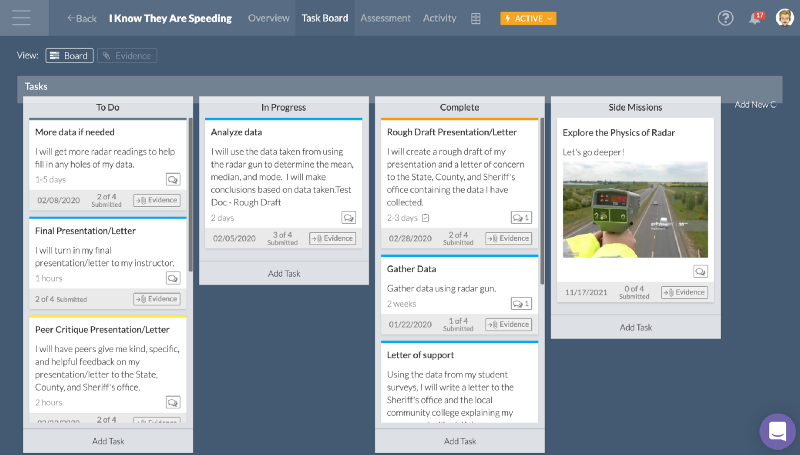
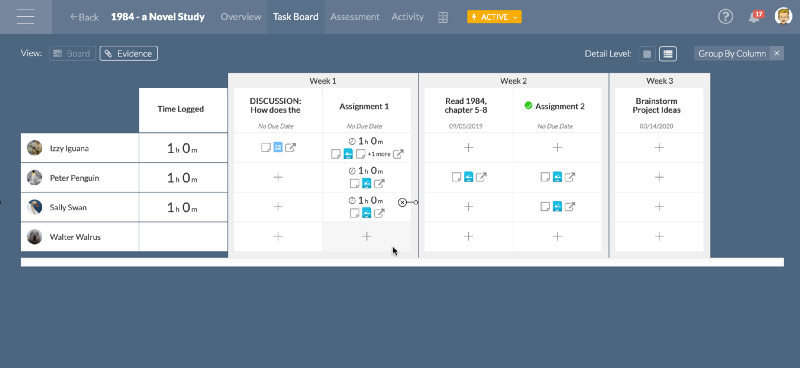
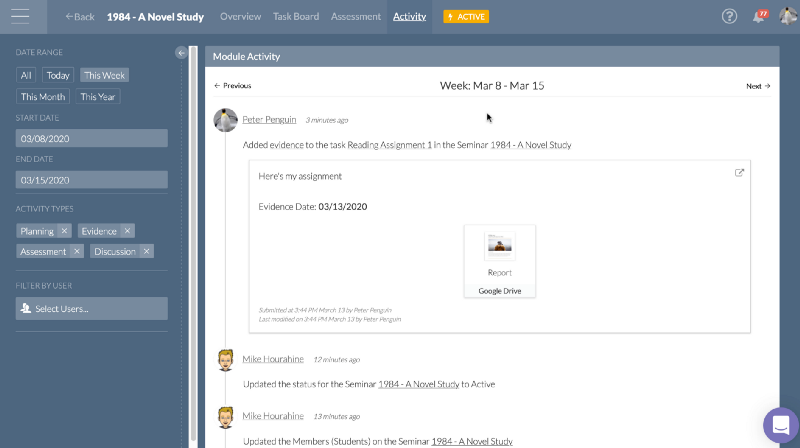
5. Remember, it’s all about connection
Some worry that online learning is transactional, and the truth is, it can be if you frame it as transactional. But it can also be transformative, if it’s framed around connection. Tech should always be used to bring communities closer together, not further apart. So the question is, how are you using tech to connect your online school community and to bring them closer together? Are you scheduling student check-ins? Educator check-ins? Parent check-ins? Are you using one power tool that allows your community members to touch base with you in real-time, like Padlet, Slack, Flipgrid, Zoom or Loom? When isolated from others, students (and the greater school community) can easily start to feel lonely and need as much connection with their peers as possible. Anytime you can use video or audio in place of text, do so during these times. This keeps social emotional balance and greater unity within your tribe. Most importantly, maintain consistent presence during online schooling. Initial check-ins aren’t enough — set routine schedules so your community knows you’re there for each other.
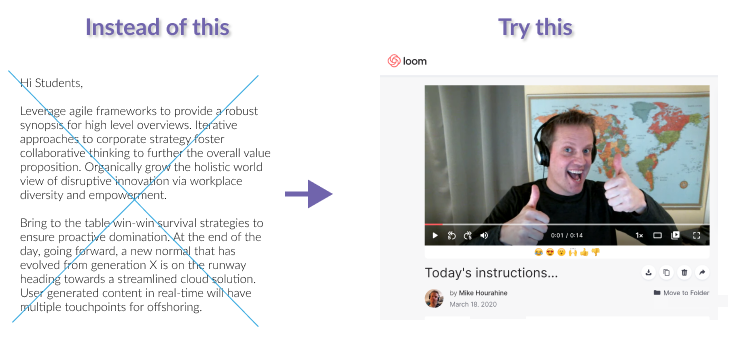
While loads of resources are being tossed around, we think the single most important thing to keep in mind is this: Learning doesn’t have to happen between the four walls of a classroom — learning can happen anytime, anyplace, anywhere. This gives us the chance to frame everything, even at home, as a learning opportunity. Joi Ito reminds us, “Education is what people do to you. Learning is what you do for yourself.” Let’s continue to empower students to learn for themselves during these exploratory months ahead. And let’s not forget that we are in this together, and that social “distancing” doesn’t have to be all that distant when you have a supportive, online community behind you. Know that we’ve got you, we support you, and we want to hear from you as well! Feel free to reach out to us at Headrush if you have any questions as we navigate this new world — together.
Additional Recommended Resources:
Teaching Effectively During Times of Disruption

